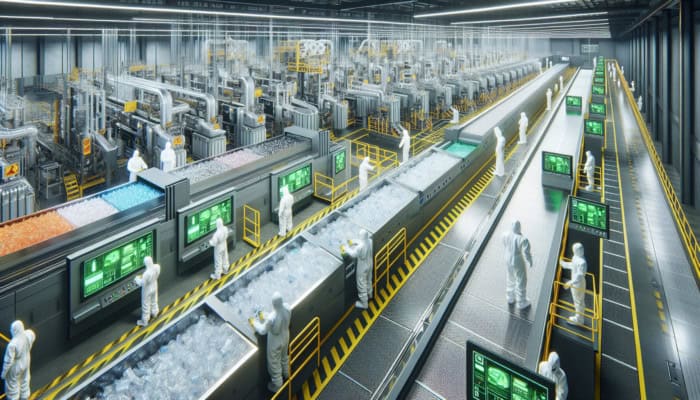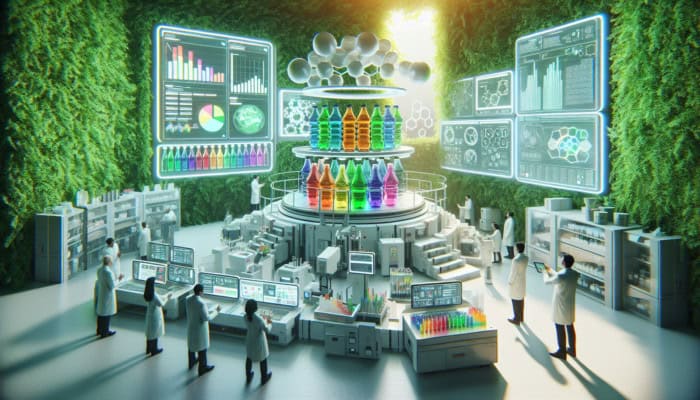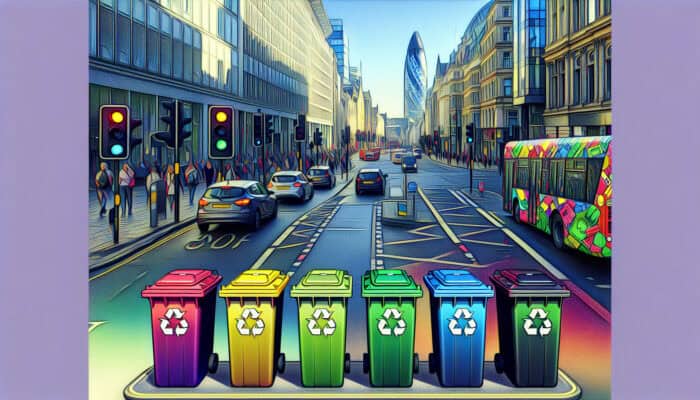Transforming Waste Management: Harnessing Advanced Recycling Methods for a Sustainable Future
Exploring the Fundamentals of Innovative Recycling Techniques

Advanced recycling methods for clearance signify a groundbreaking shift in the waste management landscape. They leverage cutting-edge technologies to convert discarded materials into valuable resources. Unlike conventional recycling methods, which face challenges related to sorting and processing, these advanced techniques utilise state-of-the-art processes that effectively decompose complex materials. This transformative approach optimises resource recovery by turning waste into high-quality raw materials and diminishes the dependency on virgin resources.
Central to these methods is the circular economy concept, which reframes waste as a resource rather than a liability. This paradigm shift is crucial for businesses and communities striving to enhance their sustainability efforts and environmental responsibility. Pioneering technologies such as chemical recycling, pyrolysis, and enzymatic recycling lead the charge, each presenting distinct efficiency and material quality benefits. By embracing these innovative methods, organisations can markedly lessen their environmental impact while actively contributing to a sustainable future.
The Critical Importance of Waste Clearance in Effective Recycling
Clearance is essential in effective waste management, especially when considering advanced recycling methods for clearance. Proper clearance entails the organised removal of waste from multiple sources, ensuring that materials are accurately sorted and processed. This step is vital for maximising the efficiency of recycling operations, as it significantly minimises contamination that could compromise the quality of recycled materials.
Effective clearance strategies are imperative for businesses, municipalities, and various industries as they promote proper waste segregation and encourage responsible disposal practices. Organisations can establish robust clearance protocols to ensure that recyclable materials are diverted from landfills, thus enhancing recovery rates and bolstering the circular economy. Moreover, efficient clearance can improve compliance with environmental regulations and positively influence public perception of waste management initiatives, fostering a culture of sustainability within communities.
The Profound Environmental Benefits of Advanced Recycling Methods
The environmental ramifications of advanced recycling methods for clearance are substantial, particularly regarding the reduction of landfill dependency and the decrease in greenhouse gas emissions. Traditional waste management practices often result in significant ecological damage, with vast quantities of waste ending up in landfills, contributing to soil contamination and water pollution. In contrast, advanced recycling technologies provide a compelling alternative by diverting waste from landfills and transforming it into valuable materials that can be reintegrated into manufacturing processes.
Additionally, advanced recycling plays a crucial role in reducing the carbon footprint associated with material production by lessening the need for virgin resources. This aspect is especially relevant in the fight against climate change, given that the extraction and processing of raw materials are often energy-intensive and detrimental to the environment. By adopting advanced recycling methods, organisations contribute to a healthier planet and align with global sustainability objectives, enhancing their corporate social responsibility initiatives.
Exploring Key Technologies Driving Advanced Recycling Methods for Clearance

Revolutionizing Plastic Waste Management with Chemical Recycling
Chemical recycling processes serve as a fundamental component of advanced recycling methods for clearance, providing a transformative solution for managing plastic waste. These processes involve breaking down plastics into their basic monomers, which can be repurposed to create new, high-quality materials. Unlike traditional recycling techniques, which can degrade plastic quality over time, chemical recycling facilitates the production of new products that retain the original properties of the materials.
Chemical recycling’s flexibility is particularly impressive, as it can be applied to a diverse array of plastic types, including those that are typically challenging to recycle, such as mixed plastics and contaminated items. By embracing this technology, organisations can considerably boost their recycling rates and divert substantial waste from landfills. Moreover, producing high-quality recycled materials through chemical processes can significantly decrease the demand for virgin plastics, thus contributing to more sustainable manufacturing practices.
Harnessing Energy from Waste: Pyrolysis and Gasification Techniques
Pyrolysis and gasification techniques are two highly efficient thermal processes utilised in advanced recycling methods for clearance. These innovative methods involve the thermal decomposition of organic materials in an oxygen-free environment, converting waste into energy and essential raw materials. Pyrolysis specifically focuses on transforming plastics into oils, gases, and char, which can be further processed or used as fuel.
Conversely, gasification converts carbon-rich materials into syngas, a hydrogen and carbon monoxide mixture that can generate electricity or produce synthetic fuels. Both techniques enhance recycling efficiency by reducing waste volumes and generating energy that can be harnessed across various applications. Integrating pyrolysis and gasification into waste management strategies can result in significant cost savings and reduced environmental impacts, making them invaluable assets in the pursuit of sustainability.
Innovative Solutions in Enzymatic Recycling

Enzymatic recycling is a groundbreaking and promising technology that employs biological agents to degrade plastics. It presents a unique and eco-friendly solution within advanced recycling methods for clearance. This innovative approach leverages specific enzymes capable of breaking down complex polymer structures into their monomers, which can subsequently be reused to manufacture new plastic products. Utilising naturally occurring biological processes for recycling not only improves the efficiency of waste management but also aligns with environmental sustainability objectives.
A key advantage of enzymatic recycling is its ability to target specific types of plastics, making it particularly effective for materials that may be challenging to recycle through traditional methods. This process also operates at relatively low temperatures and does not require harmful solvents, minimising its ecological impact. As research and development in this field continue to progress, enzymatic recycling has the potential to revolutionise our approach to plastic waste management, paving the way for a more circular economy.
Implementing Advanced Recycling Methods for Clearance: A Comprehensive Guide
Evaluating Your Organisation’s Recycling Needs
Before adopting advanced recycling methods for clearance, organisations must thoroughly evaluate their specific recycling requirements. This process involves a detailed audit of the types and volumes of waste generated within the organisation. By clearly understanding waste stream composition, businesses can tailor their recycling strategies to address the unique challenges they encounter effectively.
The initial step is identifying the primary materials within the waste stream. For example, an organisation that generates a substantial amount of plastic waste may benefit from incorporating chemical recycling technologies, while a facility producing organic waste could explore enzymatic solutions. Furthermore, understanding waste volumes can help determine the scale of recycling operations needed, ensuring that selected methods are efficient and cost-effective. This comprehensive assessment lays the foundation for successful implementation and maximises resource recovery potential.
Selecting the Most Effective Technology for Your Needs
Choosing the right technology for advanced recycling methods for clearance is a vital decision that can significantly influence the success of waste management initiatives. Factors such as cost, environmental impact, and the specific materials requiring recycling should guide this decision-making process. Each technology, whether chemical recycling, pyrolysis, or enzymatic methods, presents its own advantages and considerations.
Cost analysis is critical; businesses must evaluate the initial investment needed for technology installation against the long-term savings linked to resource recovery and reduced disposal expenses. Additionally, environmental impact should remain a primary concern as organisations strive to minimise their carbon footprints and align with sustainability goals. Ultimately, the specific materials an organisation generates will dictate the most appropriate technologies, ensuring that the chosen methods effectively address waste challenges while maximising recovery rates.
Prioritising Staff Training and Education
To optimise the efficiency and safety of advanced recycling methods for clearance, thorough training and education for staff members are crucial. Employees play a pivotal role in the success of recycling initiatives, and equipping them with the necessary knowledge and skills can greatly enhance the overall effectiveness of waste management strategies.
Training should cover various topics, including the operation of advanced recycling technologies, proper waste segregation techniques, and the significance of adhering to environmental regulations. Furthermore, cultivating a culture of sustainability within the workplace can inspire employees to engage in recycling efforts actively and promote responsible waste management practices. By investing in staff education, organisations can ensure they are well-prepared to implement advanced recycling methods successfully, ultimately leading to enhanced resource recovery and reduced environmental impact.
Real-World Success Stories: Advanced Recycling Methods for Clearance in Action
Innovative Industrial Waste Management Solutions
An exemplary illustration of advanced recycling methods for clearance can be found in the industrial sector, where a manufacturing facility successfully adopted chemical recycling processes to manage its plastic waste. Faced with rising disposal expenses and stringent environmental regulations, the facility recognised the necessity for a more sustainable approach to waste management.
By implementing a chemical recycling system, the plant could transform its plastic waste into high-quality raw materials suitable for reuse in production. This strategy diminished the volume of waste directed to landfills and significantly reduced material costs, as the plant could procure recycled materials at a fraction of the cost of virgin plastics. The success of this initiative not only improved the plant’s financial performance but also bolstered its reputation as a sustainability leader within the industry.
Engaging Municipal Recycling Programs
In the realm of municipal recycling, cities around the globe have begun to adopt advanced recycling methods for clearance to enhance waste management and effectively engage the public. A notable example involves a city that launched a comprehensive recycling program incorporating both chemical recycling and enzymatic solutions.
The city undertook extensive public awareness campaigns to educate residents about the significance of recycling and the advantages of advanced methods. As a result, participation rates in the recycling program surged, leading to a marked increase in the volume of materials collected. The city successfully processed previously unrecyclable plastics by integrating advanced technologies, diverting them from landfills and reducing overall waste production. This initiative bolstered the municipality’s sustainability efforts and fostered a sense of communal responsibility towards waste management.
Commercial Sector Advancements in Recycling
The commercial sector has also experienced remarkable innovations by implementing advanced recycling methods for clearance. Numerous businesses now employ advanced recycling technologies to achieve sustainability objectives while lowering operational costs. For instance, a leading retailer collaborated with a technology provider to establish a closed-loop recycling system for its packaging materials.
By leveraging pyrolysis technology, the retailer transformed its plastic packaging waste into reusable raw materials, significantly reducing its reliance on new plastic production. This initiative contributed to the retailer’s sustainability goals and enhanced its market position as an environmentally responsible brand. The success of such commercial innovations highlights the potential for advanced recycling to deliver economic and environmental advantages.
Exploring the Economic Advantages of Advanced Recycling Methods for Clearance
Realising Cost Savings Through Effective Resource Recovery
One of the most compelling benefits of advanced recycling methods for clearance is the substantial cost savings achievable through resource recovery. By converting waste into valuable materials, organisations can significantly lower their disposal costs while simultaneously offsetting expenses associated with purchasing virgin materials. This dual benefit creates a compelling financial incentive for businesses to invest in advanced recycling technologies.
Moreover, as regulations surrounding waste management become increasingly stringent, the potential costs of non-compliance can be substantial. By adopting advanced recycling methods, organisations can alleviate the risk of incurring fines and penalties associated with improper waste disposal. The long-term savings realised through improved resource recovery and reduced compliance expenses create a strong business case for implementing advanced recycling strategies.
Driving Job Creation and Economic Development
The growth of the recycling industry through advanced recycling methods for clearance also plays a crucial role in job creation and economic development. As organisations invest in advanced technologies, there is a corresponding demand for skilled professionals to operate and maintain these systems. This trend can create new jobs across various sectors, including engineering, operations, and environmental management.
Expanding the recycling industry also contributes to local economies by stimulating investment in innovative technologies and infrastructure. Communities prioritising sustainability and advanced recycling often experience enhanced economic resilience as they become centres for innovation and resource recovery. The positive impact of job creation and economic growth associated with advanced recycling methods underscores the importance of embracing sustainability as a catalyst for economic development.
Attractive Investment Opportunities in Recycling Technologies
As the demand for sustainable solutions continues to rise, investment opportunities in advanced recycling methods for clearance are becoming increasingly appealing. Investors recognise the potential for significant returns in the recycling sector, mainly amainlylogies are developed and existing processes are refined.
Companies specialising in advanced recycling technologies are attracting venture capital and private equity investments, propelled by the growing acknowledgment of the importance of effective waste management in addressing environmental challenges. Furthermore, public-private partnerships within the recycling industry can facilitate the emergence of innovative solutions, paving the way for further advancements in recycling technologies. As the market for recycled materials expands, the potential for lucrative investments in advanced recycling presents an enticing opportunity for forward-thinking investors.
Navigating Challenges and Solutions in Implementing Advanced Recycling Methods for Clearance
Addressing Technological Obstacles
Implementing advanced recycling methods for clearance is challenging, particularly in overcoming technological barriers. Many organisations may encounter difficulties integrating new technologies into existing waste management systems, leading to apprehensions about cost, efficiency, and compatibility.
To tackle these challenges, organisations should thoroughly evaluate potential technologies, considering scalability, ease of integration, and operational requirements. Collaborating with technology providers and industry experts can facilitate smoother transitions and yield valuable insights into best practices. By proactively addressing technological obstacles, organisations can enhance their recycling capabilities and maximise the benefits of advanced methods.
Navigating Regulatory and Policy Frameworks
The regulatory landscape surrounding advanced recycling methods for clearance is continuously evolving, presenting organisations with challenges and opportunities. Understanding the implications of local, national, and international regulations is crucial for ensuring compliance and successfully implementing advanced recycling initiatives.
Organisations should actively engage with policymakers to advocate for regulations that promote the adoption of advanced recycling technologies. This includes promoting policies incentivising investment in recycling infrastructure and streamlining permitting processes. By fostering collaborative dialogue between industry stakeholders and regulators, organisations can help shape a supportive policy environment that encourages the growth of advanced recycling methods.
Enhancing Public Perception and Awareness
Public perception significantly influences the success of advanced recycling methods for clearance, as community engagement and support are essential for effective implementation. Many may harbor misconceptions about recycling technologies, resulting in resistance or indifference towards new initiatives.
Organisations must prioritise education and outreach efforts to counter these challenges and inform the public about the benefits of advanced recycling methods. This can include hosting workshops, community events, and educational campaigns that emphasise the significance of recycling and the positive outcomes of advanced technologies. By fostering a better understanding of recycling processes and their benefits, organisations can enhance public support and participation in sustainability initiatives.
Anticipating Future Trends in Advanced Recycling Methods for Clearance
Emerging Technologies to Keep an Eye On
The landscape of advanced recycling methods for clearance is evolving rapidly, with several emerging technologies positioned to transform waste management. Innovations in artificial intelligence, machine learning, and biotechnology pave the way for more efficient and effective recycling processes.
For instance, AI-driven sorting systems can significantly enhance material recovery rates by accurately identifying and separating different waste types. Additionally, advancements in biotechnology, such as enzyme engineering, are leading to more effective methods for breaking down complex materials. As these technologies continue to advance, they hold the potential to revolutionise the recycling industry and drive the broader adoption of advanced recycling methods.
Integrating AI and Automation into Recycling Processes
Artificial intelligence (AI) and automation are increasingly crucial in improving the efficiency of advanced recycling methods for clearance. Organisations can optimise sorting processes by incorporating AI into recycling operations, monitoring equipment performance, and streamlining logistics.
Automated sorting systems equipped with AI algorithms can greatly improve the precision of material separation, reducing contamination and maximising recovery rates. Moreover, AI-powered predictive maintenance can help minimise equipment downtime and extend the lifespan of recycling machinery. As AI and automation evolve, their integration into recycling practices will become essential for organisations aiming to remain competitive in the changing waste management landscape.
Fostering Global Collaboration and Knowledge Exchange
As the world grapples with environmental challenges, global collaboration and knowledge sharing are becoming increasingly vital in advancing recycling methods for clearance. International partnerships among governments, businesses, and research institutions can facilitate the exchange of best practices and promote innovation in recycling technologies.
Collaborative initiatives can lead to the establishment of comprehensive recycling frameworks that address regional waste management challenges while promoting sustainability on a global scale. By sharing knowledge and expertise, stakeholders can accelerate the adoption of advanced recycling methods, working collectively towards a more sustainable future.
Advanced Recycling Methods for Clearance: Frequently Asked Questions and Expert Insights
What are advanced recycling methods?
Advanced recycling methods refer to innovative technologies that convert waste materials into valuable resources, surpassing traditional recycling techniques.
How do advanced recycling methods minimise environmental impact?
These methods reduce landfill dependency and greenhouse gas emissions by transforming waste into reusable materials, supporting sustainability objectives.
What types of technologies are utilised in advanced recycling?
Key technologies include chemical recycling, pyrolysis, gasification, and enzymatic recycling, each providing unique benefits for material recovery.
How can businesses effectively implement advanced recycling methods?
Organisations should evaluate their waste streams, select appropriate technologies, and invest in staff training to implement advanced recycling strategies successfully.
What economic advantages do advanced recycling methods offer?
Advanced recycling can save costs through effective resource recovery, job creation, and appealing investment prospects in recycling technologies.
What challenges do organisations encounter when implementing advanced recycling?
Common challenges include technological barriers, regulatory considerations, and public perceptions of new recycling methods.
How can the public perception of advanced recycling be enhanced?
Organisations can improve public understanding of the benefits of recycling through educational outreach, community events, and transparent communication.
What future trends should we expect in advanced recycling?
Emerging technologies, AI integration, and global collaboration are key trends anticipated to shape the future of advanced recycling methods.
What role does AI play in recycling processes?
AI enhances recycling efficiency by improving sorting accuracy, monitoring equipment performance, and optimising logistics within recycling operations.
How can cities benefit from advanced recycling methods?
By implementing advanced recycling technologies, cities can enhance waste management, boost recycling rates, and promote public participation.






